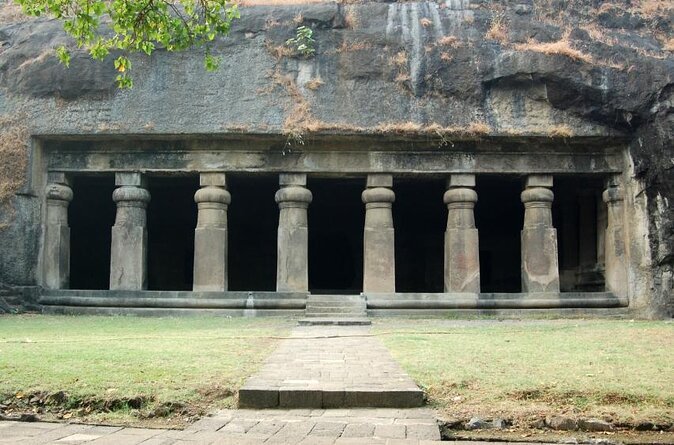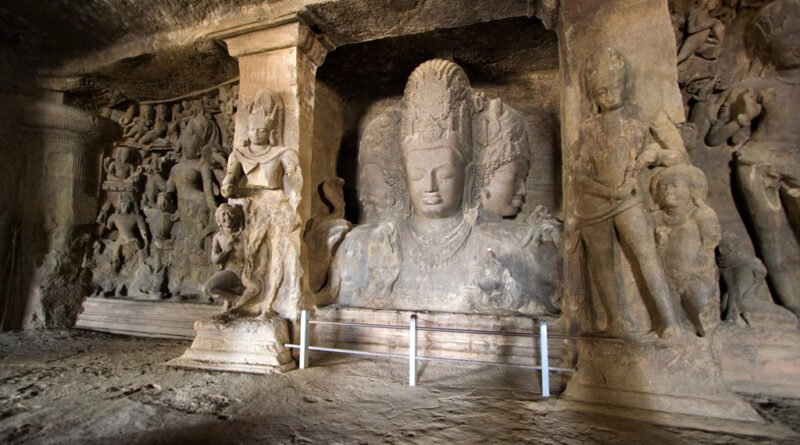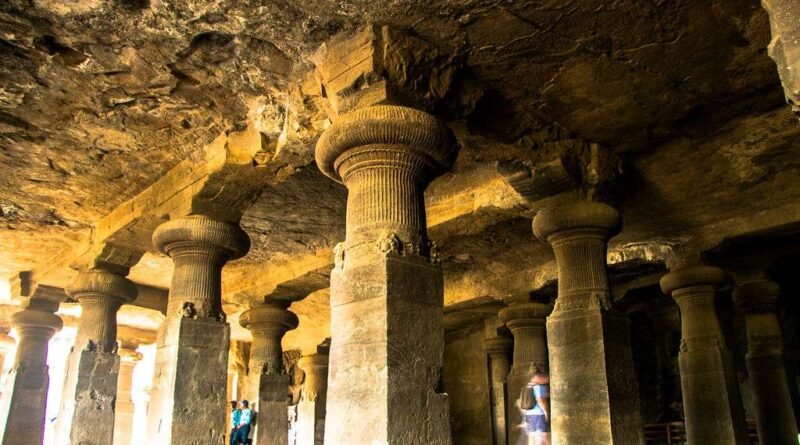Elephanta Caves Shiv Temple Mumbai
The Elephanta Caves are a collection of cave temples predominantly dedicated to the Hindu god Shiva, which have been designated a UNESCO World Heritage Site. They are on Elephanta Island, or Gharapuri (literally meaning “the city of caves”), in Mumbai Harbour, 10 kilometres (6.2 mi) east of Mumbai in the Indian state of Mahārāshtra. The island, about 2 kilometres (1.2 mi) west of the Jawaharlal Nehru Port, consists of five Hindu caves, a few Buddhist stupa mounds that date back to the 2nd century BCE, and two Buddhist caves with water tanks.
The Elephanta Caves contain rock-cut stone sculptures, mostly in high relief, that show syncretism of Hindu and Buddhist ideas and iconography. The caves are hewn from solid basalt rock. Except for a few exceptions, much of the artwork is defaced and damaged. The main temple’s orientation as well as the relative location of other temples are placed in a mandala pattern. The carvings narrate Hindu mythologies, with the large monolithic 5.45 metres (17.9 ft) Trimurti Sadashiva (three-faced Shiva), Nataraja (Lord of dance) and Yogishvara (Lord of Yoga) being the most celebrated.
These date to between the 5th and 9th centuries, and scholars attribute them to various Hindu dynasties. They are most commonly placed between the 5th and 7th centuries. Many scholars consider them to have been completed by about 550 CE.
They were named Elefante – which morphed to Elephanta – by the colonial Portuguese who found elephant statues on the caves. They established a base on the island. The main cave (Cave 1, or the Great Cave) was a Hindu place of worship until the Portuguese arrived, whereupon the island ceased to be an active place of worship. The earliest attempts to prevent further damage to the caves were started by British India officials in 1909. The monuments were restored in the 1970s. It is currently maintained by the Archaeological Survey of India (ASI).
Geography
Elephanta Island, or Gharapuri, is about 11 km (6.8 mi) east of the Gateway of India in the Mumbai Harbour and less than 2 km (1.2 mi) west of Jawaharlal Nehru Port. The island covers about 10 km2 (3.9 sq mi) at high tide and about 16 km2 (6.2 sq mi) at low tide. Gharapuri is a small village on the south side of the island. The Elephanta Caves is connected by ferry services from the Gateway of India, Mumbai between 9AM and 2PM daily, except Monday when the Caves are closed. Mumbai has a major domestic and international airport, as well as is connected to the Indian Railways.
The island is 2.4 km (1.5 mi) in length with two hills that rise to a height of about 150 m (490 ft). A narrow, deep ravine separates the two hills and runs from north to south. On the west, the hill rises gently from the sea and stretches east across the ravine and rises gradually to the extreme east to a height of 173 m (568 ft). Forest growth with clusters of mango, tamarind, and karanj trees cover the hills with scattered palm trees. The foreshore is made up of sand and mud with mangrove bushes on the fringe. Landing quays sit near three small hamlets known as Set Bunder in the north-west, Mora Bunder in the northeast, and Gharapuri or Raj Bunder in the south.
There are five rock-cut caves in the western hill and a brick stupa on the eastern hill. The eastern hill has two Buddhist mounds and is called the Stupa hill. Close to the five western hill caves, are Cave 6 and 7 on the eastern hill. The most visited and significant cave is on the western hill and is called Cave 1 or the Great Cave, located about a kilometer walk up a steep graded uphill. The Elephanta island is a protected monument area as per the requirements of UNESCO. A notification was issued by the Government of India in 1985 declaring a buffer zone that outlines “a prohibited area” that stretches 1 kilometre (0.62 mi) from the shoreline.
Description
The island has two groups of rock-cut caves, hewn from solid basalt rock. The larger group of caves, which consists of five caves on the western hill of the island, is well known for its Hindu sculptures. The primary cave, numbered as Cave 1, is about 1.0 km (0.62 mi) up a hillside, facing the Mumbai harbour. Caves 2 through 5 are next to Cave 1 further southeast, arranged in a row. Cave 6 and 7 are about 200 m (660 ft) northeast of Cave 1 and 2, but geologically on the edge of the eastern hill.
The two hills are connected by a walkway. The eastern hill is also called the Stupa hill, while the western hill is called the Canon hill, reflecting their historic colonial-era names, the ancient Stupa and the Portuguese era firing Canons they host respectively.
All the caves are rock-cut temples that together have an area of 5,600 m2 (60,000 sq ft). At their most elaborate, they have a main chamber, two lateral chambers, courtyards, and subsidiary shrines, but not all are so fully developed. Cave 1 is the largest and is 39 metres (128 ft) deep from the front entrance to the back. The temple complex is primarily the abode of Shiva, depicted in widely celebrated carvings which narrate legends and theologies of Shaivism. However, the artwork reverentially displays themes from Shaktism and Vaishnavism traditions of Hinduism as well.













